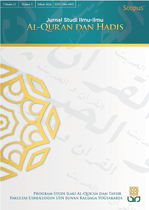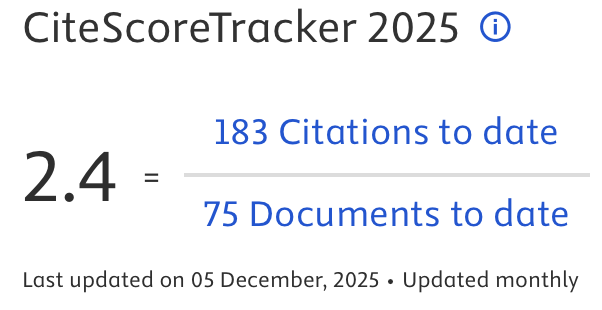The Dynamic of Contextualization in Indonesian Qur'anic Tafsirs: A Comparative Study of Tafsir Al-Azhar and Tafsir Al-Mishbāh on The Story of The Prophet Moses
DOI:
https://doi.org/10.14421/qh.v25i2.5397Keywords:
Contextualisation of Meaning, Story of Moses, Hamka, Quraish Shihab, Qur’anic TafsirsAbstract
The Indonesian Qur’anic tafsirs represent a contextual approach. Each tafsir scholar has different characteristics in contextualizing the meaning of the Qur’an so that it is relevant to contemporary Indonesian society. This article aims to show the dynamic character of Indonesian Qur’anic interpretation in contextualizing the meaning of the verses about Moses in the Indonesian context. This research uses a comparative method against the al-Azhar tafsir written by Haji Abdul Malik bin Karim Amrullah, also known as Hamka, and the Tafsir al-Mishbāh by M. Quraish Shihab. The three aspects compared and the research questions include: How is the story of Prophet Moses narrated in the two tafsir books? What are the interpretation methods used in the verses about the story of Prophet Moses, and how can the lessons from the story of Prophet Moses align with the Indonesian cultural context? The research results show that both tafsir books have similarities in making the story of Moses relevant to Indonesian society. The difference is that Tafsir al-Mishbāh appears more disciplined in following the textual meaning of the Qur’anic verses. In contrast, Tafsir al-Azhar is more flexible in its storytelling improvisation, making the story of Moses more cohesive and engaging. Shihab understands the story of Moses as Allah’s plan to overthrow human arrogance (Pharaoh), with a narrative flow following Allah’s laws. This retelling represents Shihab’s traditionalist and pragmatic thinking. In contrast, Hamka is more rational and critical. He views the story of Moses as a struggle and heroism that teaches the importance of hard work and intelligence in facing life’s challenges. The findings of this research contribute to showing the dynamic nature of Indonesian contextual tafsir. It illustrates how the Qur’anic interpretation maintains its textual meaning while remaining relevant for contemporary readers.
 Abstract viewed: 2027 times
|
Abstract viewed: 2027 times
|
 PDF downloaded = 1723 times
PDF downloaded = 1723 times
References
Abas, Nur Afifah Binti, and Mohd Nizam Sahad. “Thematic Analysis in The Social Sciences and Qur’anic Thematic Exegetical Analysis in The Qur’anic Sciences: A Comparative Analysis.” In Icis 2021, 1–14, 2021.
Alfiyah, Avif. “Metode Penafsiran Buya Hamka Dalam Tafsir Al-Azhar.” Jurnal Ilmiah Ilmu Ushuluddin 15, no. 1 (2017): 25. https://doi.org/10.18592/jiiu.v15i1.1063.
Ali, Amer. “A Brief Review of Classical and Modern Tafsir Trends and the Role of Modern Tafsir in Contemporary Islamic Thought.” Australian Journal of Islamic Studies 3, no. 2 (2018): 39–52. https://doi.org/https://ajis.com.au/index.php/ajis/article/view/87/69.
Avivy, Ahmad Levi Fachrul, Jawiah Dakir, and Mazlan Ibrahim. “Isra’iliyyat in Interpretive Literature of Indonesia: A Comparison Between Tafsir Marah Labid and Tafsir Al-Azhar.” Mediterranean Journal of Social Sciences 6, no. 3 (2015): 401–7. https://doi.org/10.5901/mjss.2015.v6n3s2p401.
Azra, Azyumardi. “The Transmission of Al-Manar’s Reformism to the Malay-Indonesian World: The Cases of Al-Imam and Al-Munir.” Studia Islamika 6, no. 3 (1999): 75–100. https://doi.org/10.15408/sdi.v6i3.723.
Basri, Basri, Mohd Nasir, Maskanatul Fiqiyah, Syamsul Rizal, and Zainuddin Zainuddin. “Dating Practices: A Moral Negotiation in Pesantren.” Jurnal Ilmiah Peuradeun 12, no. 2 (May 30, 2024): 671–94. https://doi.org/10.26811/peuradeun.v12i2.1167.
Bidin, Sharifah Norshah Bani Syed ; Wan Helmy Shahriman Wan Ahmad; Kamarul Shukri Mat Teh; Mohd Ariff Nafizi Ibrahim. “The Approach of Interpretation Implemented by Hamka in Tafsir Al-Azhar Based on Scientific Exegesis.” The International Journal of Academic Research in Business and Social Sciences 7, no. 4 (2017): 194–207. https://doi.org/DOI: 10.6007/IJARBSS/v7-i4/2798.
Campanini, Massimo. “Towards a Philosophical Qur ’ Anology : Structure and Meaning in the Qur ’ an.” Journal of Qur’anic Studies 20, no. 2 (2018): 1–18. https://doi.org/10.3366/jqs.2018.0335.
Daud, Ilyas. “Qur’anic Exegesis as Social Criticism: The Case of Tafsir Al-Azhâr.” Ulul Albab 21, no. 1 (2020): 24–47. https://doi.org/http://dx.doi.org/10.18860/ua.v21i1.7828.
Dede, Rosyada. “A Contextual Method of Interpreting the Qur’an: A Search for the Compatibility of Islam and Modernity.” In International Conference on Qura`an Hadist, 1–6. Jakarta: Atlantis, 2018.
Djidin, M, and Sahiron Syamsuddin. “Indonesian Interpretation of the Qur’an on Khilāfah: The Case of Quraish Shihab and Yudian Wahyudi on Qur’an, 2: 30-38.” Al-Jami’ah: Journal of Islamic Studies 57, no. 1 (2019): 143–66. https://doi.org/10.14421/ajis.2019.571.143-166.
Feener, R. Michael. “Notes Towards the History of Qur’anic Exegesis in Southeast Asia.” Studia Islamika 5, no. 3 (2014). https://doi.org/10.15408/sdi.v5i3.739.
Gusmian, Islah. “Tafsir Al-Qur’an Di Indonesia: Sejarah Dan Dinamika.” Nun, Jurnal Studi Al-Qur`an Dan Tafsir Di Nusantara 1, no. 1 (2015). https://doi.org/10.32459/nun.v1i1.8.
Hamka. Tafsir Al-Azhar. Singapura: Pustaka Nasional, 2003.
Hasyim, Syafiq. “Fatwa Aliran Sesat Dan Politik Hukum Majelis Ulama Indonesia (Mui).” Al-Ahkam 25, no. 2 (2015): 241. https://doi.org/10.21580/ahkam.2015.25.2.810.
Herlambang, Saifuddin, and Wendi Parwanto. “Paradigm Shifts in the Interpretation of Heaven Illustration Among Indonesian Mufassirin: A Comparative Analysis of As-Singkili, Hamka, and M. Quraish.” Jurnal Studi Ilmu-Ilmu Al-Qur’an Dan Hadis 24, no. 1 (2023): 181–204. https://doi.org/10.14421/qh.v24i1.4454.
Ismail, Norbani B. “The Qur’anic Exegesis, Reformism, and Women in Twentieth Century Indonesia.” Studia Islamika 24, no. 3 (2017): 469–501. https://doi.org/10.15408/sdi.v24i3.5187.
Jamaluddin, Jamaluddin, Milatul Hayat, Masduki Masduki, Oom Mukarromah, and Jamaludin Jamaludin. “Examining the Synthesis of Islamic Commercial Principles and Local Customary Practices: A Case Study of Nyambut Sawah Traditions in Tejamari, Banten.” Journal of Islamic Law 5, no. 1 (February 29, 2024): 86–104. https://doi.org/10.24260/jil.v5i1.2091.
Johns, A. H. “A Humanistic Approach to I ’ Jaz in the Qur’an: The Transfiguration of Language.” Journal of Qur’anic Studies 13, no. 2 (2011): 86–108. https://doi.org/10.3366/jqs.20.
———. “In Search of Common Ground: The Qur’Ān as Literature?” Islam and Christian–Muslim Relations 4, no. 2 (1993): 191–209. https://doi.org/10.1080/09596419308721006.
———. “THE QURʾĀN IN THE MALAY WORLD: REFLECTIONS ON ʿABD AL-RAʾŪF OF SINGKEL (1615–1693).” Journal of Islamic Studies 9, no. 2 (1998): 120–45.
Mir, Mustansir. “Some Aspects of Narration in the Qur’an.” In Sacred Tropes : Tanakh, New TestamenL, and Qur’an as Literature and Culture, edited by Roberta Sterman Sabbath, 93–106. (Leiden and Boston: Brill, 2009. https://doi.org/10.1163/ej.9789004177529.i-536.25.
Mujahidin, Anwar. “Indonesian Context of The Meaning of Qur`an; a Study on the Verses of Power in Tafsir Al-Azhar and Al-Mishbah.” Atlantis 137, no. Icqhs 2017 (2018): 299–308.
Mustaqim, Abdul. “The Epistemology of Javanese Qur’anic Exegesis: A Study of Sālih Darat’s Fayd Al-Rahmān.” Al-Jami’ah 55, no. 2 (2017): 357–90. https://doi.org/10.14421/ajis.2017.552.357-390.
Najib, Aan. “Contextual Qur’an Interpretation: The Study on the Concept of ‘Hierarchy of Values’ Abdullah Saeed.” Journal of Islamic Studies and Culture 4, no. 2 (2016). https://doi.org/DOI: 10.15640/jisc.v4n2a9.
Pink, Johanna. “Tradition, Authority and Innovation in Contemporary Sunnī Tafsīr: Towards a Typology of Qur’an Commentaries from the Arab World, Indonesia and Turkey.” Edinburgh: Journal of Qur’anic Studies, 2010. https://doi.org/DOI: 10.3366/E1465359110000963.
———. “Tradition, Authority and Innovation in Contemporary Sunnī Tafsīr: Towards a Typology of Qur’an Commentaries from the Arab World, Indonesia and Turkey.” Journal of Qur’anic Studies 12, no. 2010 (2010): 56–82. https://doi.org/10.3366/e1465359110000963.
———. Tradition and Ideology in Contemporary Sunnite Qur’ānic Exegesis: Qur’ānic Commentaries from the Arab World, Turkey and Indonesia and Their Interpretation of Q 5:51. Welt Des Islams. Vol. 50, 2010. https://doi.org/10.1163/157006010X489801.
Purwojuono, Ribut. “Hamka ’ s Education Thinking : Gender Equality in Islamic Education.” Journal of Social Sciences and Humanities 1, no. 2 (2015): 105–13.
Qalyubi, Syihabuddin. Ilm Al-Uslub, Stilistika Bahasa Dan Sastra Arab. Yogyakarta: Idea Press Yogyakarta, 2017.
Saeed, Abdullah. Approaches to the Qur’an in Contemporary Indonesia. Edited by Abdullah Saeed. Oxford,Britania Raya: Oxford University Press in association with The Institute of Ismaili Studies, 2005.
———. Interpreting the Qur’an: Towards a Contemporary Approach. New York: Routledge, 2006. https://doi.org/10.4324/9780203016770.
———. “Some Reflections on the Contextualist Approach to Ethico-Legal Texts of the Quran.” Bulletin of the School of Oriental and African Studies 71, no. 2 (2008): 221–37. https://doi.org/10.1017/S0041977X08000517.
———. The Qur’an: An Introduction. New York: Routledge, 2008.
Saleh, Walid A. The Formation of the Classical Tafsir Tradition: The Qur`an Commentary of Al-Tha`laby. Netherlands: Brill NV, 2004.
Shihab, M. Quraish. Logika Agama: Kedudukan Wahyu Dan Batas-Batas Akal Dalam Islam. Jakarta: Lentera Hati, 2005.
———. Membumikan Al-Qur`an, Fungsi Dan Peran Wahyu Dalam Kehidupan Masyarakat. Bandung: Mizan, 2007.
———. Tafsir Al-Mishbah; Pesan, Kesan Dan Keserasian Al-Qur`an. Jakarta: Lentera Hati, 2008.
Sirry, Mun`im. “What`s Modern About Modern Tafsir ? A Closer Look at Hamka`s Tafsir Al-Azhar.” In The Qur ʾān in the Malay – Indonesian World, 1–261. London and New York: Routledge, 2016.
Steenbrink, Karel. “Qur’ an Interpretations of Hamzah Fansuri (CA. 1600) and Hamka (1908-1982): An Comparison.” Studia Islamika 2, no. 2 (1995): 46–71.
Sukhiashvili, Teona. “Moses in the Qur’an.” Journal of Religious and Theological Information 20, no. 1 (2020): 1–9. https://doi.org/10.1080/10477845.2020.1832361.
Wheeler, Brannon M. “Moses or Alexander Early Islamic Exegesis of Qurʾān 1860-60-65.” Journal of Near Eastern Studies 57, no. 3 (1998): 191–215.
Yusdi, Hafiz Asyraf Amir, Siti Nursyakirah Yuslan, Mohd Noh Abdul Jalil, and Ismail bin, and Mamat. “A Comparative Study between Risale-i Nur and Tafsīr Al-Azhar’s Methodology in Quranic Exegesis and Its Relation to the Daʿwah.” Journal of Islam in Asia 17, no. 4 (2020): 329–49.
Yusri, Muhammad, Yusof Salleh, and Cawangan Perak. “Hamka ’ S Interpretation Metodology in Education and Muamalat With Special Reference To Tafsir Al-Azhar Juzuk Amma,” 0–6, 2018.
Downloads
Published
How to Cite
Issue
Section
License
Copyright (c) 2024 Anwar Mujahidin, Itmam, Rofiq

This work is licensed under a Creative Commons Attribution-NonCommercial-NoDerivatives 4.0 International License.
Publishing your paper with Jurnal Studi Ilmu-ilmu al-Qur'an dan Hadis means that the author or authors retain the copyright in the paper. Jurnal Studi Ilmu-ilmu al-Qur'an dan Hadis uses license CC-BY-NC-ND or an equivalent license as the optimal license for the publication, distribution, use, and reuse of scholarly works. This license permits anyone to copy and redistribute the material in any medium or format and must give appropriate credit, provide a link to the license, and indicate if changes were made. If you remix, translate, transform or build upon the material you may use it for private use only and not for distribution. Jurnal Studi Ilmu-ilmu al-Qur'an dan Hadis granted an exclusive non-commercial reuse license by the author(s), but the author(s) are able to put the paper onto a website, distribute it to colleagues, give it to students, use it in your thesis, etc, so long as the use is not directed at a commercial advantage or toward private monetary gain. The author(s) can reuse the figures and tables and other information contained in their paper published by Jurnal Studi Ilmu-ilmu al-Qur'an dan Hadis in future papers or work without having to ask anyone for permission, provided that the figures, tables, or other information that is included in the new paper or work properly references the published paper as the source of the figures, tables or other information, and the new paper or work is not direct at a private monetary gain or commercial advantage.
Jurnal Studi Ilmu-ilmu al-Qur'an dan Hadis journal Open Acces articles are distrubuted under the Creative Commons Attribution-NonCommercial-NoDerivatives 4.0 International (CC BY-NC-ND 4.0). Article can be read, copy and redistribute the material ini any medium or format under the following conditions:
Attribution — You must give appropriate credit, provide a link to the license, and indicate if changes were made. You may do so in any reasonable manner, but not in any way that suggests the licensor endorses you or your use.
NonCommercial — You may not use the material for commercial purposes.
NoDerivatives — If you remix, transform, or build upon the material, you may not distribute the modified material.










